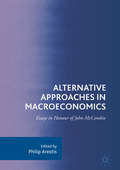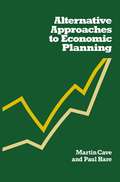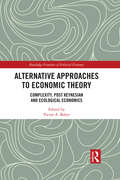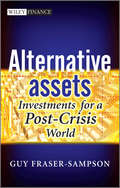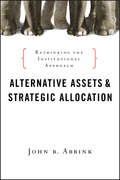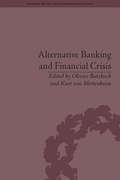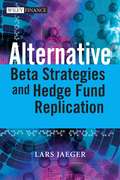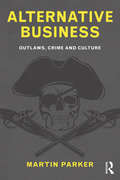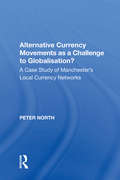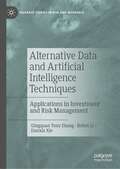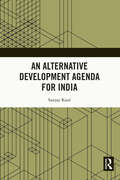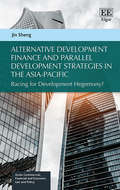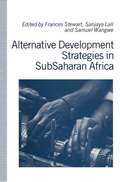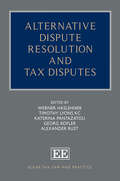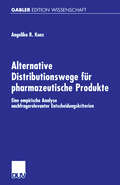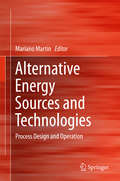- Table View
- List View
Alternative Approaches in Macroeconomics: Essays In Honour Of John Mccombie
by Philip ArestisThis book honours Professor John McCombie’s retirement by exploring a variety of themes, theories and debates in non-orthodox macroeconomics. With contributions from leading scholars, the book covers diverse ground in economic thought, policy, empirical work and modelling. It demonstrates ongoing presumptions and asks probing questions of topical questions from the increase of income equality to the international variation of productivity investment. This collection will appeal to academics and students with an interest in the history of macroeconomic thinking.
Alternative Approaches in Macroeconomics: Essays in Honour of John McCombie
by Philip ArestisThis book honours Professor John McCombie’s retirement by exploring a variety of themes, theories and debates in non-orthodox macroeconomics. With contributions from leading scholars, the book covers diverse ground in economic thought, policy, empirical work and modelling. It demonstrates ongoing presumptions and asks probing questions of topical questions from the increase of income equality to the international variation of productivity investment. This collection will appeal to academics and students with an interest in the history of macroeconomic thinking.
Alternative Approaches to Economic Theory: Complexity, Post Keynesian and Ecological Economics (Routledge Frontiers of Political Economy)
by Víctor A. BekerThe 2007–2008 financial crisis exposed the shortcomings of mainstream economic theory with economists unprepared to deal with it. In the face of this, a major rethinking of economics seems necessary and in presenting alternative approaches to economic theory, this book contributes to the rebuilding of the discipline. This volume brings together contributions from different perspectives and theoretical approaches that address the challenge of updating the economic theory corpus and seek to recover prestige for this discipline after the failure of neoclassical economics. It addresses a range of topics, including the complexity approach to economics, category theory, the Post-Keynesian approach to micro and macroeconomics, financialisation, multidimensional analysis and ecological economics. The book is aimed at economics scholars, researchers, academics and practitioners, as well as upper undergraduates and graduates in this area of knowledge. It may also be of interest for people interested in methodological issues in economics and the relationship between economic theory and the real world.
Alternative Approaches to Economic Theory: Complexity, Post Keynesian and Ecological Economics (Routledge Frontiers of Political Economy)
by Victor A. BekerThe 2007–2008 financial crisis exposed the shortcomings of mainstream economic theory with economists unprepared to deal with it. In the face of this, a major rethinking of economics seems necessary and in presenting alternative approaches to economic theory, this book contributes to the rebuilding of the discipline. This volume brings together contributions from different perspectives and theoretical approaches that address the challenge of updating the economic theory corpus and seek to recover prestige for this discipline after the failure of neoclassical economics. It addresses a range of topics, including the complexity approach to economics, category theory, the Post-Keynesian approach to micro and macroeconomics, financialisation, multidimensional analysis and ecological economics. The book is aimed at economics scholars, researchers, academics and practitioners, as well as upper undergraduates and graduates in this area of knowledge. It may also be of interest for people interested in methodological issues in economics and the relationship between economic theory and the real world.
Alternative Assets: Investments for a Post-Crisis World (The Wiley Finance Series)
by Guy Fraser-SampsonThe investment landscape has changed dramatically over the last few years, destroying many of the old certainties by which investors lived their lives. In particular, it has shaken belief in the ability of traditional asset types such as bonds and equities to protect them from abnormal market conditions, and it has brought home how closely correlation between different markets can be squeezed together by extreme pressure. Future investors will have to regard so-called "alternative" assets as essential elements within their portfolios, and be prepared to deal with the complexities that this will entail. This will in turn force a re-appraisal of core concepts such as "risk" and "return", not least because some alternative asset classes do not lend themselves well to traditional return measures. Exciting times lie ahead, but a thorough working knowledge of the various alternative asset classes will be an essential pre-requisite to success, and perhaps even to survival. Alternative Assets meets investor's need for a guide on where to allocate in this new climate. It provides investors with a primer on each alternative asset class, as well as practical tips on the pros and cons, implementation, returns analysis, fees and costs. It also offers introductory guidance on how to set investment targets, and how alternative assets can be accommodated within the allocation process. Each chapter gives useful background knowledge on a particular asset type, including a discussion of whether a satisfactory beta return level exists and, if so, the different ways in which it might be accessed. Written by best-selling author Guy Fraser-Sampson, this book guides investors through the new look alternative investment arena, providing post-financial crisis perspective and investment advice on the alternatives landscape.
Alternative Assets: Investments for a Post-Crisis World
by Guy Fraser-SampsonThe investment landscape has changed dramatically over the last few years, destroying many of the old certainties by which investors lived their lives. In particular, it has shaken belief in the ability of traditional asset types such as bonds and equities to protect them from abnormal market conditions, and it has brought home how closely correlation between different markets can be squeezed together by extreme pressure. Future investors will have to regard so-called "alternative" assets as essential elements within their portfolios, and be prepared to deal with the complexities that this will entail. This will in turn force a re-appraisal of core concepts such as "risk" and "return", not least because some alternative asset classes do not lend themselves well to traditional return measures. Exciting times lie ahead, but a thorough working knowledge of the various alternative asset classes will be an essential pre-requisite to success, and perhaps even to survival. Alternative Assets meets investor's need for a guide on where to allocate in this new climate. It provides investors with a primer on each alternative asset class, as well as practical tips on the pros and cons, implementation, returns analysis, fees and costs. It also offers introductory guidance on how to set investment targets, and how alternative assets can be accommodated within the allocation process. Each chapter gives useful background knowledge on a particular asset type, including a discussion of whether a satisfactory beta return level exists and, if so, the different ways in which it might be accessed. Written by best-selling author Guy Fraser-Sampson, this book guides investors through the new look alternative investment arena, providing post-financial crisis perspective and investment advice on the alternatives landscape.
Alternative Assets and Strategic Allocation: Rethinking the Institutional Approach (Bloomberg #94)
by John B. AbbinkAn insightful guide to making strategic investment allocation decisions that embraces both alternative and conventional assets In this much-needed resource, alternative and portfolio management expert John Abbink demonstrates new ways of analyzing and deploying alternative assets and explains the practical application of these techniques. Alternative Assets and Strategic Allocation clearly shows how alternative investments fit into portfolios and the role they play in an investment allocation that includes traditional investments as well. This book also describes innovative methods for valuation as applied to alternatives that previously have been difficult to analyze. Offers institutional investors, analysts, researchers, portfolio managers, and financial academics a down-to-earth method for measuring and analyzing alternative assets Reviews some of the latest alternatives that are increasing in popularity, such as high-frequency trading, direct lending, and long-term investment in real assets Outlines a strategic approach for including alternative investments into portfolios and shows the pivotal role they play in an investment allocation Using the information found in this book, you'll have a clearer sense of how to approach investment issues related to alternative assets and discover what it takes to make these products work for you.
Alternative Assets and Strategic Allocation: Rethinking the Institutional Approach (Bloomberg #134)
by John B. AbbinkAn insightful guide to making strategic investment allocation decisions that embraces both alternative and conventional assets In this much-needed resource, alternative and portfolio management expert John Abbink demonstrates new ways of analyzing and deploying alternative assets and explains the practical application of these techniques. Alternative Assets and Strategic Allocation clearly shows how alternative investments fit into portfolios and the role they play in an investment allocation that includes traditional investments as well. This book also describes innovative methods for valuation as applied to alternatives that previously have been difficult to analyze. Offers institutional investors, analysts, researchers, portfolio managers, and financial academics a down-to-earth method for measuring and analyzing alternative assets Reviews some of the latest alternatives that are increasing in popularity, such as high-frequency trading, direct lending, and long-term investment in real assets Outlines a strategic approach for including alternative investments into portfolios and shows the pivotal role they play in an investment allocation Using the information found in this book, you'll have a clearer sense of how to approach investment issues related to alternative assets and discover what it takes to make these products work for you.
Alternative Banking and Financial Crisis (Banking, Money and International Finance #1)
by Olivier Butzbach Kurt Von MettenheimThe recent banking crisis has brought into question the business model used by most large banks. This collection of essays explores the success of ‘alternative banks’ – savings banks, cooperative banks and development banks, using case studies from around the world and discussion of both the historical and theoretical context of banking practices.
Alternative Banking and Financial Crisis (Banking, Money and International Finance)
by Kurt Von Mettenheim Olivier ButzbachThe recent banking crisis has brought into question the business model used by most large banks. This collection of essays explores the success of ‘alternative banks’ – savings banks, cooperative banks and development banks, using case studies from around the world and discussion of both the historical and theoretical context of banking practices.
Alternative Beta Strategies and Hedge Fund Replication
by Lars Jaeger Jeffrey PeaseThere s a buzzword that has quickly captured the imagination of product providers and investors alike: "hedge fund replication". In the broadest sense, replicating hedge fund strategies means replicating their return sources and corresponding risk exposures. However, there still lacks a coherent picture on what hedge fund replication means in practice, what its premises are, how to distinguish di erent approaches, and where this can lead us to. Serving as a handbook for replicating the returns of hedge funds at considerably lower cost, Alternative Beta Strategies and Hedge Fund Replication provides a unique focus on replication, explaining along the way the return sources of hedge funds, and their systematic risks, that make replication possible. It explains the background to the new discussion on hedge fund replication and how to derive the returns of many hedge fund strategies at much lower cost, it differentiates the various underlying approaches and explains how hedge fund replication can improve your own investment process into hedge funds. Written by the well known Hedge Fund expert and author Lars Jaeger, the book is divided into three sections: Hedge Fund Background, Return Sources, and Replication Techniques. Section one provides a short course in what hedge funds actually are and how they operate, arming the reader with the background knowledge required for the rest of the book. Section two illuminates the sources from which hedge funds derive their returns and shows that the majority of hedge fund returns derive from systematic risk exposure rather than manager "Alpha". Section three presents various approaches to replicating hedge fund returns by presenting the first and second generation of hedge fund replication products, points out the pitfalls and strengths of the various approaches and illustrates the mathematical concepts that underlie them. With hedge fund replication going mainstream, this book provides clear guidance on the topic to maximise returns.
Alternative Business: Outlaws, Crime and Culture (Routledge Companions In Business, Management And Accounting Ser.)
by Martin ParkerFrom Robin Hood to Jack Sparrow from Pirates of the Caribbean, outlaws have been a central part of 800 years of culture. These are characters who criticise the power of those in the castle or the skyscraper, and earn their keep by breaking the law. Outlaws break categories too. They are fact and fiction, opposition and product, culture and economy, natural justice and organized crime. Beginning with Robin Hood stealing from the rich, and covering along the way pirates, smugglers, highwaymen, the Wild West, the Mafia and many others, Martin Parker offers a fresh and exciting insight into the counter culture of the outlaw – one that rebels against the more dominant and traditional forms of economy and organization and celebrates a life free from wage slavery. Alternative Business is a highly readable, entertaining book that will prove a helpful study tool for all students and lecturers working on organizations, cultural studies and criminology.
Alternative Business: Outlaws, Crime and Culture
by Martin ParkerFrom Robin Hood to Jack Sparrow from Pirates of the Caribbean, outlaws have been a central part of 800 years of culture. These are characters who criticise the power of those in the castle or the skyscraper, and earn their keep by breaking the law. Outlaws break categories too. They are fact and fiction, opposition and product, culture and economy, natural justice and organized crime. Beginning with Robin Hood stealing from the rich, and covering along the way pirates, smugglers, highwaymen, the Wild West, the Mafia and many others, Martin Parker offers a fresh and exciting insight into the counter culture of the outlaw – one that rebels against the more dominant and traditional forms of economy and organization and celebrates a life free from wage slavery. Alternative Business is a highly readable, entertaining book that will prove a helpful study tool for all students and lecturers working on organizations, cultural studies and criminology.
Alternative countrysides: Anthropological approaches to rural Western Europe today (PDF)
by Jeremy MacclancyA fresh anthropological look at a central but neglected topic: the profound changes in rural life throughout Western Europe today. As locals leave for jobs in cities they are replaced by neo-hippies, lifestyle-seekers, eco-activists, and labour migrants from beyond the EU. With detailed ethnographic examples, contributors analyse new modes of living rurally and emerging forms of social organisation. As incomers' dreams come up against residents' realities, they detail the clashes and the cooperations between old and new residents. They make us rethink the rural/urban divide, investigate regionalists' politicisation of rural life and heritage, and reveal how locals use EU monies to prop up or challenge existing hierarchies. They expose the consequences of and reactions to grand EU-restructuring policies, which at times threaten to turn the countryside into a manicured playground for escapee urbanites. This book will appeal to anyone seriously interested in the realities of rural life today.
Alternative Currency Movements as a Challenge to Globalisation?: A Case Study of Manchester's Local Currency Networks
by Peter NorthOver the past 15 years, local money networks, which are essentially trading networks using a community-created currency, have emerged in countries as far apart as Argentina, Australia and New Zealand, Canada and the US, continental Europe and Japan. They range from Local Exchange Trading Schemes (UK), to Time Dollars (US), Green Dollars (New Zealand, Australia and Canada), Trading Circles (Hungary), Barter Networks (Argentina) and Talents (Germany). Drawing on an ethnographic case study of alternative currency movements in Manchester, UK, this book provides an analysis of the motivations, aims, successes and failures of alternative currency networks. It also raises questions such as the contribution of the alternative currency movement to current debates about alternatives to neoliberalism. While it is theoretically informed, critical and grounded in fieldwork, it is also sympathetic to the political aims of the protagonists and cognisant of the non-economic benefits that arise from their development.
Alternative Currency Movements as a Challenge to Globalisation?: A Case Study of Manchester's Local Currency Networks
by Peter NorthOver the past 15 years, local money networks, which are essentially trading networks using a community-created currency, have emerged in countries as far apart as Argentina, Australia and New Zealand, Canada and the US, continental Europe and Japan. They range from Local Exchange Trading Schemes (UK), to Time Dollars (US), Green Dollars (New Zealand, Australia and Canada), Trading Circles (Hungary), Barter Networks (Argentina) and Talents (Germany). Drawing on an ethnographic case study of alternative currency movements in Manchester, UK, this book provides an analysis of the motivations, aims, successes and failures of alternative currency networks. It also raises questions such as the contribution of the alternative currency movement to current debates about alternatives to neoliberalism. While it is theoretically informed, critical and grounded in fieldwork, it is also sympathetic to the political aims of the protagonists and cognisant of the non-economic benefits that arise from their development.
Alternative Data and Artificial Intelligence Techniques: Applications in Investment and Risk Management (Palgrave Studies in Risk and Insurance)
by Qingquan Tony Zhang Beibei Li Danxia XieThis book introduces a state-of-art approach in evaluating portfolio management and risk based on artificial intelligence and alternative data. The book covers a textual analysis of news and social media, information extraction from GPS and IoTs data, and risk predictions based on small transaction data, etc. The book summarizes and introduces the advancement in each area and highlights the machine learning and deep learning techniques utilized to achieve the goals. As a complement, it also illustrates examples on how to leverage the python package to visualize and analyze the alternative datasets, and will be of interest to academics, researchers, and students of risk evaluation, risk management, data, AI, and financial innovation.
An Alternative Development Agenda for India
by Sanjay KaulThis book provides a revamped, transformative, and fiscally sustainable developmental agenda for India to radically improve the well-being and livelihoods of its citizens. Grounded in a ‘people first’ approach, this alternative agenda focuses on seven vital development and inter-connected areas, including health, education, food and nutrition, child development, gender, livelihood and jobs, and urbanization. The volume highlights the systemic issues plaguing these sectors and offers pragmatic and implementable solutions to address them. The author takes cognizance of the COVID-19 pandemic and draws attention to the limitations of the current public policies and suggests cost-effective interventions and strategies that focus on the poor. The volume discusses crucial themes of universalizing healthcare, battling malnutrition and food insecurity, ensuring quality schooling, unshackling gendered mindsets, enhancing livelihoods and improving the urban quality of life to spell out a pragmatic and workable development agenda for India. Accessible and reader-friendly, the book will be an essential read for scholars and researchers of development studies, economics, public policy, governance, development policy, public administration, political studies, South Asia studies. It will also be of interest to professionals in the development sector.
An Alternative Development Agenda for India
by Sanjay KaulThis book provides a revamped, transformative, and fiscally sustainable developmental agenda for India to radically improve the well-being and livelihoods of its citizens. Grounded in a ‘people first’ approach, this alternative agenda focuses on seven vital development and inter-connected areas, including health, education, food and nutrition, child development, gender, livelihood and jobs, and urbanization. The volume highlights the systemic issues plaguing these sectors and offers pragmatic and implementable solutions to address them. The author takes cognizance of the COVID-19 pandemic and draws attention to the limitations of the current public policies and suggests cost-effective interventions and strategies that focus on the poor. The volume discusses crucial themes of universalizing healthcare, battling malnutrition and food insecurity, ensuring quality schooling, unshackling gendered mindsets, enhancing livelihoods and improving the urban quality of life to spell out a pragmatic and workable development agenda for India. Accessible and reader-friendly, the book will be an essential read for scholars and researchers of development studies, economics, public policy, governance, development policy, public administration, political studies, South Asia studies. It will also be of interest to professionals in the development sector.
Alternative Development Finance and Parallel Development Strategies in the Asia-Pacific: Racing for Development Hegemony? (Asian Commercial, Financial and Economic Law and Policy series)
by Jin ShengThis insightful book examines the impact of two competing visions of Asian-Pacific economic growth paths and development governance. It discusses law, development and finance in the context of the Indo-Pacific Strategy versus the Belt and Road Initiative (BRI), whilst also comparing parallel development financing systems.Jin Sheng reflects on and connects a series of issues of global significance, such as the economic Cold War, global debt, industrialisation and development in the developing world, and the changing international economic order. In so doing the author posits that the BRI’s ultimate objective is to export China’s development model, which is characterised by a focus on exports, experimentalism, and oversupply of currency. The book also critically examines China’s ambition to dominate the international economic order and set up its own favoured international rules.Alternative Development Finance and Parallel Development Strategies in the Asia-Pacific will be an important read for researchers and policy makers in the fields of law, development and finance in the Asia-Pacific region.
Alternative Development Strategies in SubSaharan Africa
by Frances Stewart Sanjaya Lall Samuel M. WangweThe World Bank and the IMF dominate policy-making in Africa today. This book considers the consistency between their adjustment policies and long-run development needs, with an analysis of country experience. An alternative development strategy is proposed.
Alternative Dispute Resolution and Tax Disputes (Elgar Tax Law and Practice series)
Arbitration has been promoted as the future of tax dispute resolution in recent years in line with the increase in complexity of international tax law. This authoritative book presents existing legal rules on the matter, provides a review of the arguments in favour of tax arbitration, discusses the practical and legal challenges for its wide-spread adoption and compatibility with existing domestic and international norms. It also answers key questions for the practical implementation of a modern tax arbitration system.Key Features:Comprehensive analysis of the existing tax treaty framework and their application to MAP and arbitrationUp-to-date guidance on the best practices in alternative dispute resolution to ensure effective and efficient dispute resolutionOriginal insights from dispute resolution mechanisms found in non-tax areas such as trade and investment lawIn-depth discussion of primary and secondary EU law rules on tax dispute resolution, including implications of EU general principles, fundamental rights and internal market rulesIdentifying some of the new issues in tax arbitration and offering views on how to tackle them in the most appropriate way, this book will be a key resource for tax law practitioners looking for the latest insights on how to navigate the legal framework for alternative tax dispute resolution. Students and academics focusing on commercial and tax law will also benefit from this detailed guide.
Alternative Distributionswege für pharmazeutische Produkte: Eine empirische Analyse nachfragerelevanter Entscheidungskriterien
by Angelika KunzAngelika R. Kunz legt eine detaillierte Analyse alternativer Distributionswege aus Nachfragersicht vor. Theoretisch fundiert identifiziert und bewertet sie relevante Einflusskriterien für das Beschaffungsverhalten.
Alternative Energy Sources and Technologies: Process Design and Operation
by Mariano MartínPresenting a comprehensive analysis of the use of alternative sources of energy and technologies to produce fuels and power, this book describes the energy value chain from harvesting the raw material, (i.e solar, wind, biomass or shale gas) followed by analysis of the processing steps into power, fuels and/or chemicals and finally the distribution of the products.Featuring an examination of the techno-economic processes and integration opportunities which can add value to by-products or promote the use of different sources of energy within the same facility, this book looks at the tools that can make this integration possible as well as utilising a real world case study. The case study of the operation of “El hierro” island is used as an example of the current effort towards more efficient use of the resources available. Tackling head on the open challenges of the supply, the variability of the source and its prediction, the description of novel processes that are being developed and evaluated for their transformation as well as how we can distribute them to the consumer and how we can integrate the new chemicals, fuels and power within the current system and infrastructure, the book takes a process based perspective with such an approach able to help us in the use and integration of these sources of energy and novel technologies.
